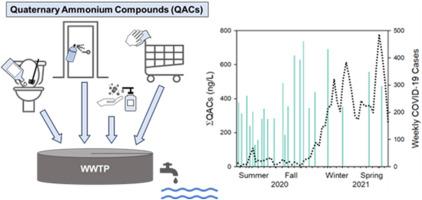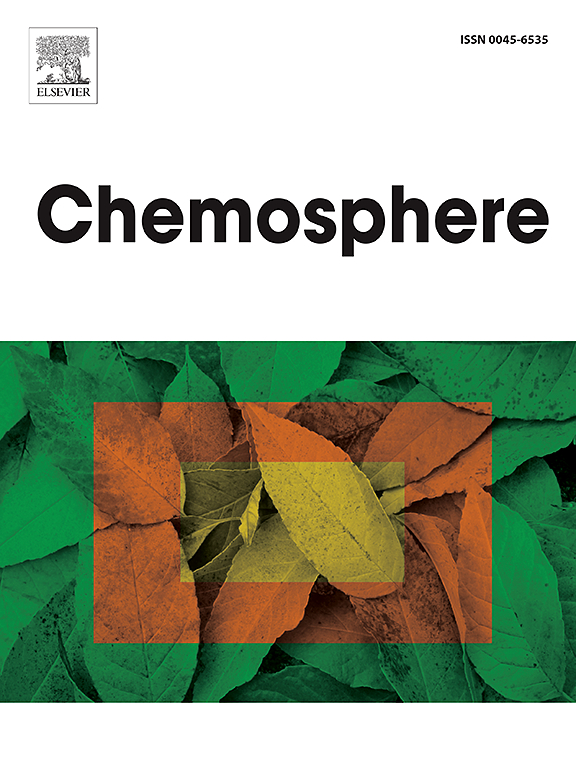2020-2021 年 COVID-19 大流行期间废水处理废水中季铵化合物的时间浓度。
IF 8.1
2区 环境科学与生态学
Q1 ENVIRONMENTAL SCIENCES
引用次数: 0
摘要
季铵盐化合物 (QAC) 是一种高产化学品,用于许多商业和家用消毒产品。在 SARS-CoV-2 (COVID-19) 大流行期间,QAC 被列入 COVID-19 消毒剂清单。QAC 使用量的增加可能会导致污水处理厂(WWTP)排放物中的 QAC 水平升高,进而释放到环境中。为了评估污水处理厂废水中的 QAC,从 2020 年 5 月到 2021 年 8 月,对美国东北部的三家污水处理厂进行了监测。目标 QAC 包括六种苄基烷基二甲基铵化合物 (BAC)、三种二烷基二甲基铵化合物 (DADMAC)、两种乙基苄基烷基二甲基铵化合物 (EBAC) 和苄铵。每个样本中至少检测到一种 QAC,单个浓度高达 1,600 纳克/升。BAC-C14 的检测频率最高,在 93% 的污水样本中均有发现;BAC-C12、BAC-C16、EBAC-C12 和 EBAC-C14 的检测率均超过 80%。在每周 COVID-19 案例中,几乎没有观察到 QAC 浓度的时间模式:在第 2 污水处理厂,DADMAC-C8:C10 和 DADMAC-C10 呈正相关,而 DADMAC-C8 呈负相关。第一污水處理廠有幾個季節趨勢,包括ƩDADMAC 的顯著差異,秋季高於夏季;ƩBAC 在秋季高於春季和夏季;ƩQAC 在秋季高於春季。本文章由计算机程序翻译,如有差异,请以英文原文为准。

Temporal concentrations of Quaternary ammonium compounds in wastewater treatment effluents during the COVID-19 pandemic, 2020–2021
Quaternary ammonium compounds (QAC) are high production chemicals used in many commercial and household disinfection products. During the SARS-CoV-2 (COVID-19) pandemic, QACs were included on lists of COVID-19 disinfectants. Increased QAC use could lead to higher levels of QACs in wastewater treatment plant (WWTP) effluents, which could subsequently be released into the environment. To evaluate QACs in WWTP effluent, three WWTPs in the northeastern United States were monitored from May 2020 through August 2021. Target QACs included six benzylalkyldimethyl ammonium compounds (BAC), three dialkyldimethyl ammonium compounds (DADMAC), two ethylbenzylalkyldimethyl ammonium compounds (EBAC), and benzethonium. At least one QAC was detected in every sample with individual concentrations up to 1600 ng L−1. BAC-C14 was detected most frequently, found in 93% of effluent samples; BAC-C12, BAC-C16, EBAC-C12 and EBAC-C14 were all detected in greater than 80% of samples. Few temporal patterns were observed in QAC concentrations with respect to weekly COVID-19 cases: at WWTP 2, DADMAC-C8:C10 and DADMAC-C10 were positively correlated, and DADMAC-C8 negatively correlated. There were several seasonal trends at WWTP 1, including significant differences of ƩDADMAC, which were higher in fall than summer; ƩBAC was higher during the fall than both spring and summer; and ƩQAC where higher during the fall than spring.
求助全文
通过发布文献求助,成功后即可免费获取论文全文。
去求助
来源期刊

Chemosphere
环境科学-环境科学
CiteScore
15.80
自引率
8.00%
发文量
4975
审稿时长
3.4 months
期刊介绍:
Chemosphere, being an international multidisciplinary journal, is dedicated to publishing original communications and review articles on chemicals in the environment. The scope covers a wide range of topics, including the identification, quantification, behavior, fate, toxicology, treatment, and remediation of chemicals in the bio-, hydro-, litho-, and atmosphere, ensuring the broad dissemination of research in this field.
 求助内容:
求助内容: 应助结果提醒方式:
应助结果提醒方式:


